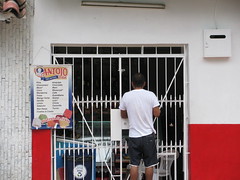- Latest Plant Press has interesting stuff on botanical data of various forms. Always worth a skim.
- CSA pamphlet on the importance of crop wild relatives. Why does this feel like a bandwagon? And how long to the backlash?
- And talking of bandwagons, here’s the latest from the one on citizen botany. Does indigenous tree knowledge count as citizen science? How about indigenous weed knowledge?
- And how about using your pet pig to reinvigorate a breed?
- Interesting take on fruit variety names. Can we crowdsource an answer?
- Everything about the opening of that new Mexican mega-genebank. Including the speeches. Nice-looking building, I must say. And from IRRI an example of a genebank from the other end of the scale in the Philippines. And similar, but different, from
CanadaColorado. - Biodiversity bigshots beg for naming blitz. Better hurry. And don’t forget the soil.
- Sargasso Sea coming ashore in Ghana is bad news for fisherfolk. Can they not eat it? Is it bad to ask that?
- How to find your way around weather data.
- Swedes to provide IPR training for PGR types.
- Island nations from opposite sides of the world brought together by agrobiodiversity. Full disclosure: I’ve worked with both regional PGR networks and want to again.
- Brits who worked on spuds.
- And Wontoks who worked on taro.
- Privatizing conservation.
Nibbles: Transgenic American Chestnuts, Moraceae conference, Breadfruit uses, Coconut oil, Potato history, Rat meat
- Transgenic American Chestnuts on trial, as it were.
- 1st International Symposium on Jackfruit and other Moraceae to take place 31 August-2 September. Don’t expect access to the papers if you can’t be there. h/t CFF.
- Breadfruit better than DEET at deterring mosquitoes. Tastier too.
- Crawford Fund opening up opportunities for coconut oil producers.
- History of the potato among the Basques. Well, why not?
- Microkhan disembowels the rat-meat trade of Mozambique.
Older fruits do it more healthily
Oh, golly, it seems the question I asked in a post a few months back entitled “Is modern plant breeding bad for your health?” may be about to receive an answer…
Nibbles: Encomium to Bioversity, PGR economics, Europe newsletter, Mapping urban veggies, Piper, Fruit breeding
- On farm conservation; Bioversity is really good at it. (And I sometimes make a linking mistake; mea maxima culpa.)
- Economics of plant genetic resource management for adaptation to climate change. What’s the bottom line? No idea.
- Something else Bioversity is really good at: newsletters.
- Using GIS to help communities map vegetable production and marketing in Bangkok. I like the acronym: V-GIS.
- The variety of non-chile peppers.
- Older fruits better. Quentin Crisp unavailable for comment.
